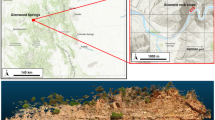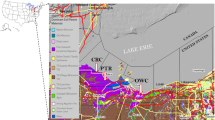Abstract
A number of coastal areas have been suffering from severe land subsidence, which draws worldwide attention. Quantifying the subsidence and the contribution of each compacting stratum is crucial to study its development mechanism. In this paper, the distributed fiber optic sensing (DFOS) technique based on Brillouin scattering was adopted to monitor land subsidence in a 100-m-deep borehole located in Tianjin, China. Vertical strain profile was obtained by a kind of fixed-point cable embedded in the borehole, and the DFOS-based land subsidence system successfully achieved a 2-year-period in-situ investigation of the soft soil. The results revealed that the land subsidence rate was 21.6 mm/a after 2017, and the strata deformation measurements were refined up to each 5-m-thickness in vertical direction. The compression strata were localized at shallow strata (3.4–38.4 m), and the dominant contributors were soft soil strata at depth of 3.4 m to 18.4 m that the contribution of every 5 m thick stratum from top to bottom was 34.4%, 27% and 19.1%, respectively. The subsidence and strata contribution obtained by DFOS were in good agreement with those of extensometers. The groundwater fluctuations and additional loading may be the significant triggering factors of the compaction of the soft soil. This study showed that the DFOS-based measurement is an effective approach for land subsidence monitoring and will be a supplement to existing techniques in coastal areas.











Similar content being viewed by others
References
ASTM D (2017) Standard practice for classification of soils for engineering purposes (unified soil classification system). ASTM International, West Conshohocken, PA, 2017. www.astm.org vol D2487-17. https://doi.org/10.1520/D2487-17E01
Baldi P, Casula G, Cenni N, Loddo F, Pesci A (2009) GPS-based monitoring of land subsidence in the Po Plain (Northern Italy). Earth Planet Scix Lett 288:204–212. https://doi.org/10.1016/j.epsl.2009.09.023
Barrias A, Casas JR, Villalba S (2016) A Review of Distributed Optical Fiber Sensors for Civil Engineering Applications. Sensors (Basel) 16:748. https://doi.org/10.3390/s16050748
Cui Z-D, Tang Y-Q, Yan X-X (2009) Centrifuge modeling of land subsidence caused by the high-rise building group in the soft soil area. Environ Earth Sci 59:1819–1826. https://doi.org/10.1007/s12665-009-0163-9
Davis GH (1987) Land subsidence and sea level rise on the Atlantic Coastal Plain of the United States. Environ Geol Water Sci 10:67–80
Erkens G, Bucx T, Dam R, de Lange G, Lambert J (2015) Sinking cities: an integrated approach to solutions. In: Proceedings of the making of a riskier future: how our decisions are shaping future disaster risk. World Bank, Washington, DC, pp 90–100
Gu K, Shi B, Liu C, Jiang H, Li T, Wu J (2018) Investigation of land subsidence with the combination of distributed fiber optic sensing techniques and microstructure analysis of soils. Eng Geol 240:34–47. https://doi.org/10.1016/j.enggeo.2018.04.004
Guo H et al (2017) The evolution characteristics and mechanism of the land subsidence in typical areas of the North China Plain. Geol China 44:1115–1127 (in Chinese with English abstract)
Hauswirth D, Puzrin AM, Carrera A, Standing JR, Wan MSP (2014) Use of fibre-optic sensors for simple assessment of ground surface displacements during tunnelling. Géotechnique 64:837–842. https://doi.org/10.1680/geot.14.T.009
Hu R, Wang S, Lee C, Li M (2002) Characteristics and trends of land subsidence in Tanggu, Tianjin, China. Bull Eng Geol Environ 61:213–225. https://doi.org/10.1007/s100640100132
Hu B, Zhou J, Wang J, Chen Z, Wang D, Xu S (2009) Risk assessment of land subsidence at Tianjin coastal area in China. Environ Earth Sci 59:269–276. https://doi.org/10.1007/s12665-009-0024-6
Iten M (2012) Novel applications of distributed fiber-optic sensing in geotechnical engineering, vol 19632. vdf Hochschulverlag AG
Iten M, Ravet F, Niklès M, Facchini M, Hertig T, Hauswirth D, Puzrin A (2009) Soil-embedded fiber optic strain sensors for detection of differential soil displacements. In: Proceedings of 4th international conference on structural health monitoring on intelligent infrastructure (SHMII-4), pp 22–24
Jia X (2015) Current ground deformation along the east coastal region of China derived from GPS observations (2010–2014). (Master Thesis), University of Houston
Kogure T, Okuda Y (2018) Monitoring the vertical distribution of rainfall-induced strain changes in a landslide measured by distributed fiber optic sensing with Rayleigh backscattering. Geophys Res Lett 45:4033–4040. https://doi.org/10.1029/2018gl077607
Koster K, Erkens G, Zwanenburg C (2016) A new soil mechanics approach to quantify and predict land subsidence by peat compression. Geophys Res Lett 43:10792–10799. https://doi.org/10.1002/2016gl071116
Koster K, Stafleu J, Stouthamer E (2018) Differential subsidence in the urbanised coastal-deltaic plain of the Netherlands. Neth J Geosci 97:215–227. https://doi.org/10.1017/njg.2018.11
Kunisue S, Kokubo T (2010) In situ formation compaction monitoring in deep reservoirs using optical fibres. Land Subsid Ass Hazards Role Nat Resourc Dev 339:368–370
Ma F, Wei A, Han Z, Zhao H, Guo J (2011) The characteristics and causes of land subsidence in Tanggu based on the GPS survey system and numerical simulation. Acta Geol Sin-English Ed 85:1495–1507. https://doi.org/10.1111/j.1755-6724.2011.00601.x
Melis M, Medina L, Rodríguez JM (2002) Prediction and analysis of subsidence induced by shield tunnelling in the Madrid Metro extension. Can Geotech J 39:1273–1287. https://doi.org/10.1139/t02-073
Ohno H, Naruse H, Kihara M, Shimada A (2001) Industrial applications of the BOTDR optical fiber strain sensor. Opt Fiber Technol 7:45–64. https://doi.org/10.1006/ofte.2000.0344
Shearer TR (1998) A numerical model to calculate land subsidence, applied at Hangu in China. Eng Geol 49:85–93. https://doi.org/10.1016/s0013-7952(97)00074-4
Teatini P, Tosi L, Strozzi T (2011) Quantitative evidence that compaction of Holocene sediments drives the present land subsidence of the Po Delta, Italy. J Geophys Res. https://doi.org/10.1029/2010jb008122
Temmerman S, Meire P, Bouma TJ, Herman PM, Ysebaert T, De Vriend HJ (2013) Ecosystem-based coastal defence in the face of global change. Nature 504:79–83. https://doi.org/10.1038/nature12859
Terzaghi K (1925) Principles of soil mechanics: IV-settlement and consolidation of clay. Eng News-Rec 95:874–878
Tomas R, Herrera G, Lopez-Sanchez JM, Vicente F, Cuenca A, Mallorquí JJ (2010) Study of the land subsidence in Orihuela City (SE Spain) using PSI data: distribution, evolution and correlation with conditioning and triggering factors. Eng Geol 115:105–121. https://doi.org/10.1016/j.enggeo.2010.06.004
Törnqvist TE et al (2008) Mississippi Delta subsidence primarily caused by compaction of Holocene strata. Nat Geosci 1:173–176. https://doi.org/10.1038/ngeo129
Wang J, Gao W, Xu S, Yu L (2012) Evaluation of the combined risk of sea level rise, land subsidence, and storm surges on the coastal areas of Shanghai, China. Clim Change 115:537–558. https://doi.org/10.1007/s10584-012-0468-7
Wang J, Yi S, Li M, Wang L, Song C (2018) Effects of sea level rise, land subsidence, bathymetric change and typhoon tracks on storm flooding in the coastal areas of Shanghai. Sci Total Environ 621:228–234. https://doi.org/10.1016/j.scitotenv.2017.11.224
Wu J, Jiang H, Su J, Shi B, Jiang Y, Gu K (2015) Application of distributed fiber optic sensing technique in land subsidence monitoring. J Civ Struct Health Monit 5:587–597. https://doi.org/10.1007/s13349-015-0133-8
Wu Y-X, Lyu H-M, Shen JS, Arulrajah A (2018) Geological and hydrogeological environment in Tianjin with potential geohazards and groundwater control during excavation. Environ Earth Sci 77:392. https://doi.org/10.1007/s12665-018-7555-7
Xue Y-Q, Zhang Y, Ye S-J, Wu J-C, Li Q-F (2005) Land subsidence in China. Environ Geol 48:713–720. https://doi.org/10.1007/s00254-005-0010-6
Yang J, Cao G, Han D, Yuan H, Hu Y, Shi P, Chen Y (2019) Deformation of the aquifer system under groundwater level fluctuations and its implication for land subsidence control in the Tianjin coastal region. Environ Monit Assess 191:162. https://doi.org/10.1007/s10661-019-7296-4
Yi L, Zhang F, Xu H, Chen SJ, Wang W, Yu Q (2011) Land subsidence in Tianjin, China. Environ Earth Sci 62:1151–1161. https://doi.org/10.1007/s12665-010-0604-5
Zhang D, Shi B, Cui HL, Xu HZ (2004) Improvement of spatial resolution of Brillouin optical time domain reflectometer using spectral decomposition. Opt Appl 34:291–302
Zhang C-C et al (2018a) Vertically distributed sensing of deformation using fiber optic sensing. Geophys Res Lett 45:11732–11741. https://doi.org/10.1029/2018gl080428
Zhang C-C, Zhu H-H, Liu S-P, Shi B, Zhang D (2018b) A kinematic method for calculating shear displacements of landslides using distributed fiber optic strain measurements. Eng Geol 234:83–96. https://doi.org/10.1016/j.enggeo.2018.01.002
Zhang T, Shen W-B, Wu W, Zhang B, Pan Y (2019) Recent surface deformation in the tianjin area revealed by Sentinel-1A data. Remote Sens 11:130. https://doi.org/10.3390/rs11020130
Zhang C-C, Zhu H-H, Liu S-P, Shi B, Cheng G (2020a) Quantifying progressive failure of micro-anchored fiber optic cable–sand interface via high-resolution distributed strain sensing. Can Geotechn J 57:871–881. https://doi.org/10.1139/cgj-2018-0651
Zhang C-C, Shi B, Zhu H-H, Wang B-J, Wei G-Q (2020b) Toward distributed fiber-optic sensing of subsurface deformation: a theoretical quantification of ground-borehole-cable interaction. J Geophys Res Solid Earth 125:e2019JB018878. https://doi.org/10.1029/2019jb018878
Zhao M, Liu J, Liu Y, Zheng H (2006) Deformation mechanism and settlement forecast of soft clay embankment in coastal region. J Highway Transport Res Dev (English Edn) 1(35):39. https://doi.org/10.1061/jhtrcq.0000140
Acknowledgements
This work was supported by the National Natural Science Foundation of China grants (41427801 and 41977217), China Geological Survey Project grants (DD20190260, 12120115043201 and 121201006000182401), Postgraduate Research & Practice Innovation Program of Jiangsu Province grant (KYCX19_0048) and China Scholarship Council (201906190153). We would like to thank Jian-Hui He and Chang-Yu Zhang from Nanjing University, Guang-Qing Wei and Qiu-Sheng Zhang from Suzhou NanZee Sensing Technology Ltd, and all those from Tianjin Center, China Geological Survey who were involved in the land subsidence monitoring in Tianjin for their field and technical assistance.
Author information
Authors and Affiliations
Corresponding authors
Ethics declarations
Conflict of interest
The authors declare that they have no conflict of interest.
Additional information
Publisher's Note
Springer Nature remains neutral with regard to jurisdictional claims in published maps and institutional affiliations.
Rights and permissions
About this article
Cite this article
Liu, SP., Shi, B., Gu, K. et al. Land subsidence monitoring in sinking coastal areas using distributed fiber optic sensing: a case study. Nat Hazards 103, 3043–3061 (2020). https://doi.org/10.1007/s11069-020-04118-1
Received:
Accepted:
Published:
Issue Date:
DOI: https://doi.org/10.1007/s11069-020-04118-1




